Introduction
A market is best described as a group of willing sellers and able buyers of a certain product or service. Competitive markets are constituted by many sellers and buyers hence they have remarkably little influence on the prices of commodities. Therefore, supply and demand curve becomes a powerful model in such markets, and it explains how customers and sellers interact.
Quantity Demand and Supply
Demand is the “amount of product that customers are able and willing to buy” (Bernanke 26). Quantity demand is the specified amount of product at a given cost required by buyers. The Law of demand hence states that, when other factors are held constant (ceteris paribus), the fall in demand will cause an increase in price (Wonderling, Gruen, and Black 34).
Supply, on the other hand, is the amount of products that sellers are able and willing to take to the market and sell. Quantity supplied is the amount of product that suppliers bring for sale at a certain price (Wonderling, Gruen, and Black 34). Price is, hence, a major determinant of demand/supply. Other factors include “income, prices of substitutes or complements, expectations, taste, and preferences” (Wonderling, Gruen, and Black 36).
In the health sector, healthcare insurance has an exceptional role in attaining a balance. When the market is unregulated, it will result in private health insurance and the impact on moral hazard will not depend on the objective of taking the insurance. With insurance in place, there are often tradeoffs of objectives (Santerre, and Neun 214). The more people are insured, the less risk and the more the demand and, therefore, cost.
This scenario underscores why most economists will approve of supply side controls as minimal possible option for dealing with the problem. Voluntary health insurance results in two main issues viz. cream skimming and adverse selection.
Contrary to the moral hazard, these two issues are merely social problems when health insurance is covering distinct statuses only (Santerre, and Neun 214). Conventionally, this understanding holds that, when a market fails to supply normal services at a price that everyone can buy, it is not a market failure.
Deriving the Price
Price is determined when supply and demand interact. The resultant market price depends on both demand and supply in the market. There can be an exchange of goods and services whenever buyers and sellers agree on a certain price them (Taylor, and Weerapana 116). When the seller and the buyer agree on a price, this phenomenon is termed as the ‘equilibrium’. This point is also the market clearing price as shown in Figure 1:
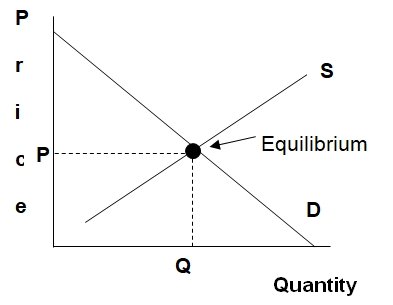
Figure 1: equilibrium
The customers and suppliers are both able and willing to do the exchange at price P and quantity Q. At this point, the supply and demand are balanced. At any price below the P, the demand will be higher that the supply and vice versa. At lower prices than P, the buyers will be eager to obtain products or services that the suppliers are not able to supply.
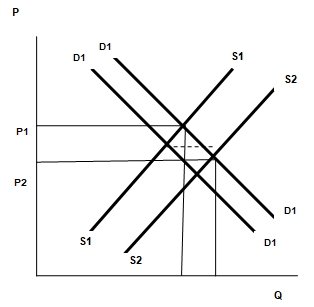
Figure 2: shifts in demand and supply
The normal market price is not normally fair to all the players in the market. The prices do not guarantee satisfaction for buyers and sellers. The competitive positions in the market may determine satisfaction. The consumers will tend to maximize their satisfaction in the competitive limits (Taylor and Weerapana 116). Lower prices will benefit the consumers more, hence, induce competition. Higher prices attract more suppliers hence increase competition and equilibriums shift. Figure 2 illustrates this:
Healthcare supply and demand are distinctive. Care cannot be pulled off the stores and supplied to the users then paid via cash as other commodities. The desired outcome cannot be guaranteed in such a case (Santerre, and Neun 215). Many of the factors affecting supply and demand of healthcare are far much beyond the control of the healthcare providers.
Its analysis is thus, based on two fundamental perceptions of the effective use of the medical resources. First, economics should not be a resource allocation scheme and second, efficiency in the use of resources in healthcare can be comprehended by identification of the production function, which represents the supply of care (Folland, Goodman, and Stano 355).
In the event that the demand and supply changes, there will be a shift in the equilibrium price, as well. Considering that there is not an increase in supply, the movement will be along the demand curve to a new equilibrium price where excess supplies will be cleared off the market (Baumol and Blinder 67). The customer will only purchase more products at a lower price. Figure 3 illustrates this:
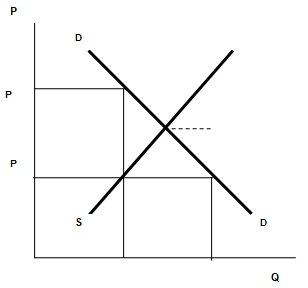
Figure 3: Shift in Price
A shift in demand because of the factors that influence consumption will also cause a change in the price. When supply is not affected, the net impact on the price will be movement along the supply curve to a lower equilibrium where a new balance is found between the supply and demand (Bernanke 84). For prices to increase, suppliers will be forced to reduce the quantity they supply to the market. The result is a shift in demand to a new price point which also a new equilibrium (Bernanke 84). The figure below represents these changes.
The changes in demand and supply can be exceedingly short lived or long lasting. There are numerous non price factors that affect the market price in a short period; for instance, taste and preferences on the part of the consumer or change in technology of the supplier (Bernanke 84).
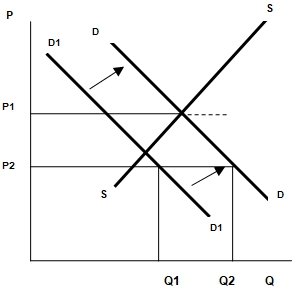
Figure 4: Shift in demand
Healthcare Demand-Supply Curve
The behaviour of the market forces can be analyzed by looking at the demand supply curves. In health care, it is evident that a different form of a curve will be produced. In the private health care market, price and quantity obey the supply-demand model (Santerre, and Neun 215).
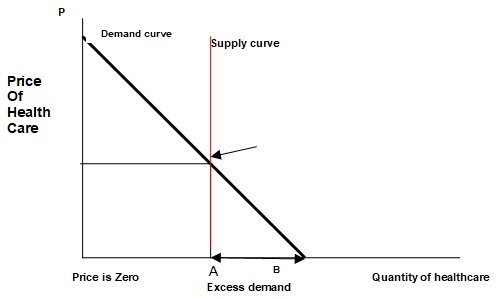
Figure 5: Healthcare demand –supply curve
However, because healthcare is an essential product, governments always intervene to ensure that everyone has access to care. Two crucial points should be noted; one, the price at the point of consumption is zero and two, the supply is normally fixed at any one point (Henderson 33). Even when practitioners are continuously being trained, the government that decides when there is a need and when to increase the number of care providers that are fully qualified (Henderson 33). Therefore in the short-run the demand-supply curve and equilibrium are particularly odd as in figure 5.
The supply curve is vertical since, unlike other consumer products, the government can only supply a fixed amount of health care in a certain short period (Folland, Goodman, and Stano 355). The demand curve remains normal, but since the price is zero, the excess demand is unusually extensive from A to B, and the outcome of this scenario is that, there will be queues and long-waiting list in the healthcare facilities. Besides, progress in technology continues to create new demands, hence the demand curve continues shifting to the right at a faster rate than the government can manipulate the supply curve to shift to the right (Folland, Goodman, and Stano 414).
Conclusion
Economists agree that the health sector is complex, and it is described by some unusual problems. The orthodox economists in general content that patients (demand) are protected from the price (cost) of care by the health insurance. This increases demand (a moral hazard). Removing demand strains causes complication in a competitive market.
Works Cited
Baumol, William, and Blinder, Alan. Macroeconomics: Principles and Policy. New York: Cengage Learning, 2008. Print
Bernanke, Ben. Principles of Microeconomics. Boston: McGraw-Hill, 2003. Print
Folland, Sherman, Goodman, Allen, and Stano, Miron. The Economics of Health and Health Care. New Jersey: Pearson Prentice Hall, 2007. Print
Henderson, James. Health Economics & Policy. New York: Cengage Learning, 2009.
Santerre, Rexford, and Neun, Stephen. Health Economics: Theories, Insights, and Industry Studies. New York: Cengage Learning, 2010. Print
Taylor, John, and Weerapana, Akila. Principles of Economics: Global Financial Crisis. New York: Cengage Learning, 2009. Print
Wonderling, David, Gruen, Reinhold, and Black, Nick. Introduction to Health Economics: Understanding Public Health. Berkshire: Open University Press, 2005. Print